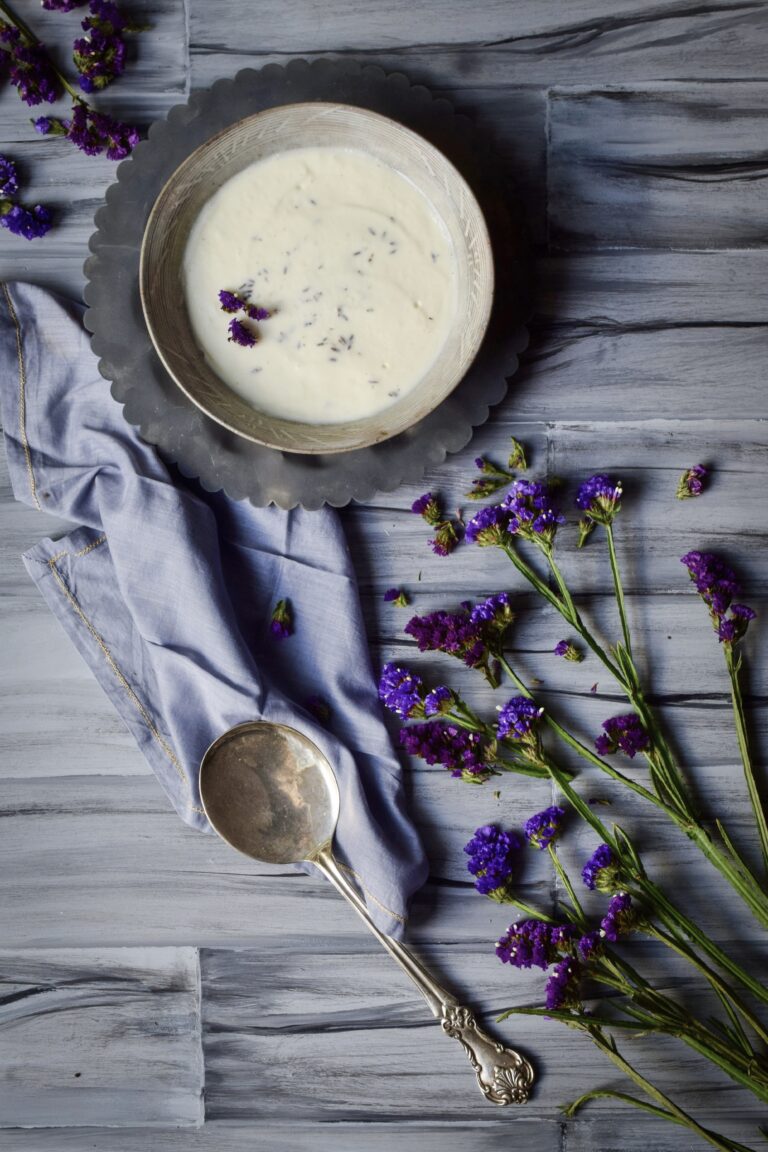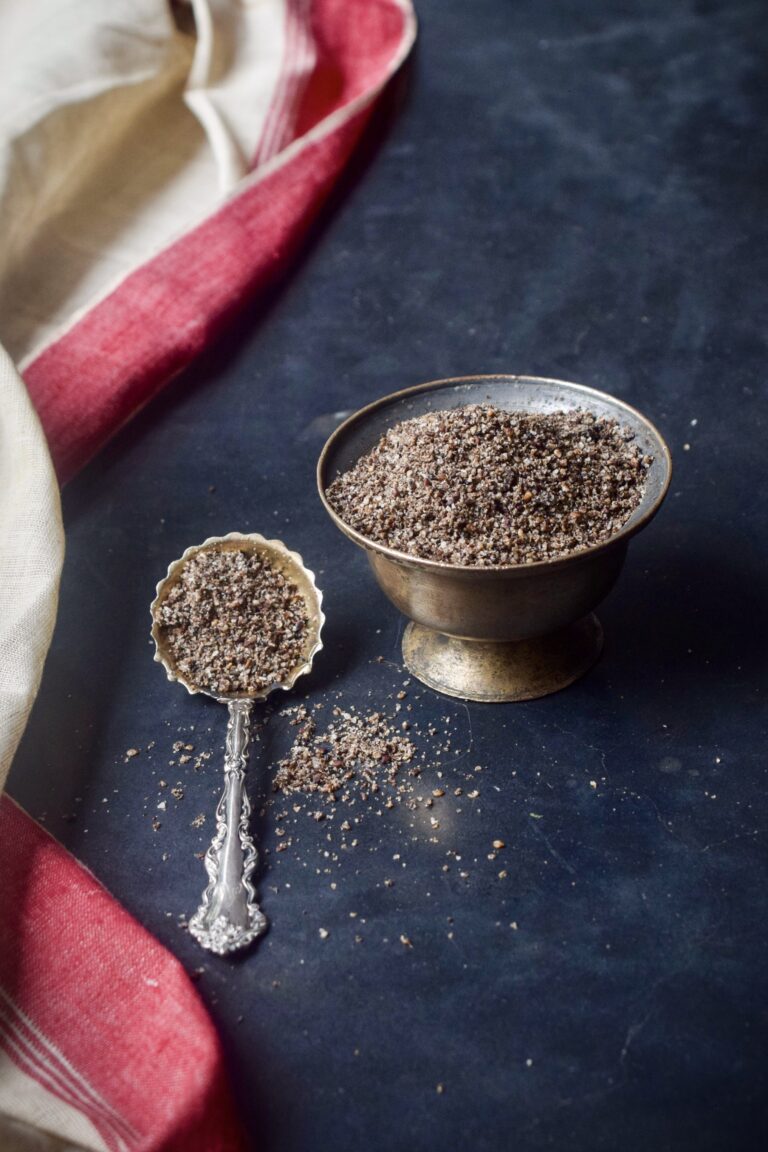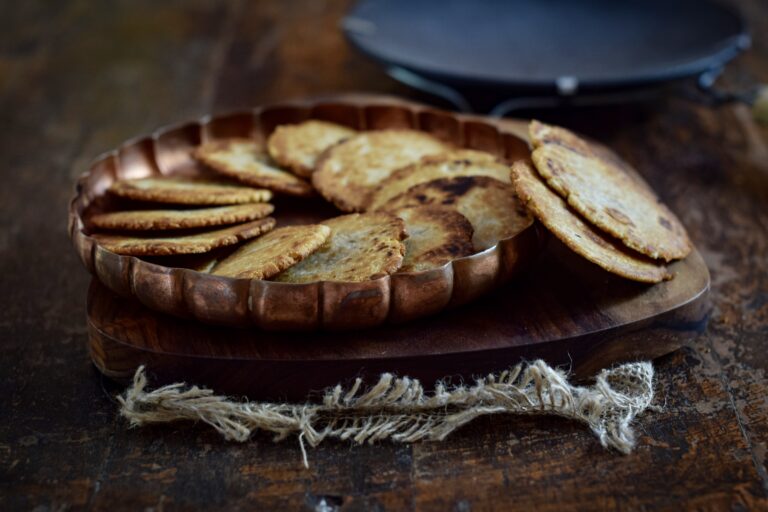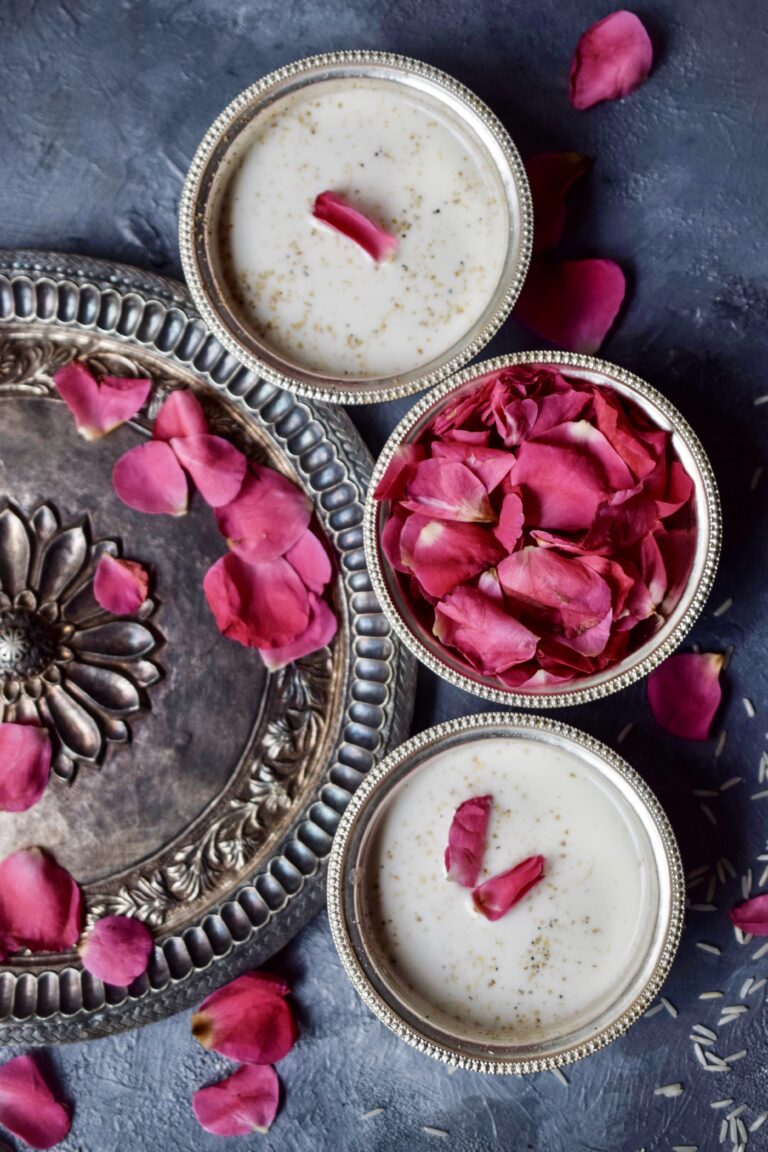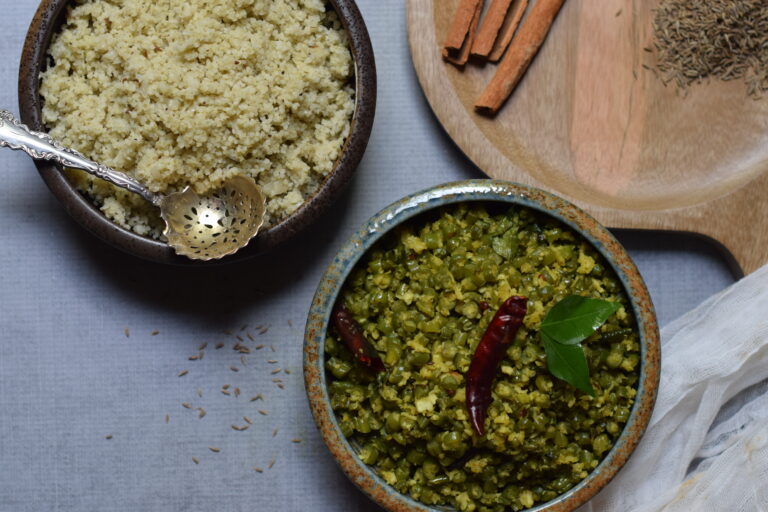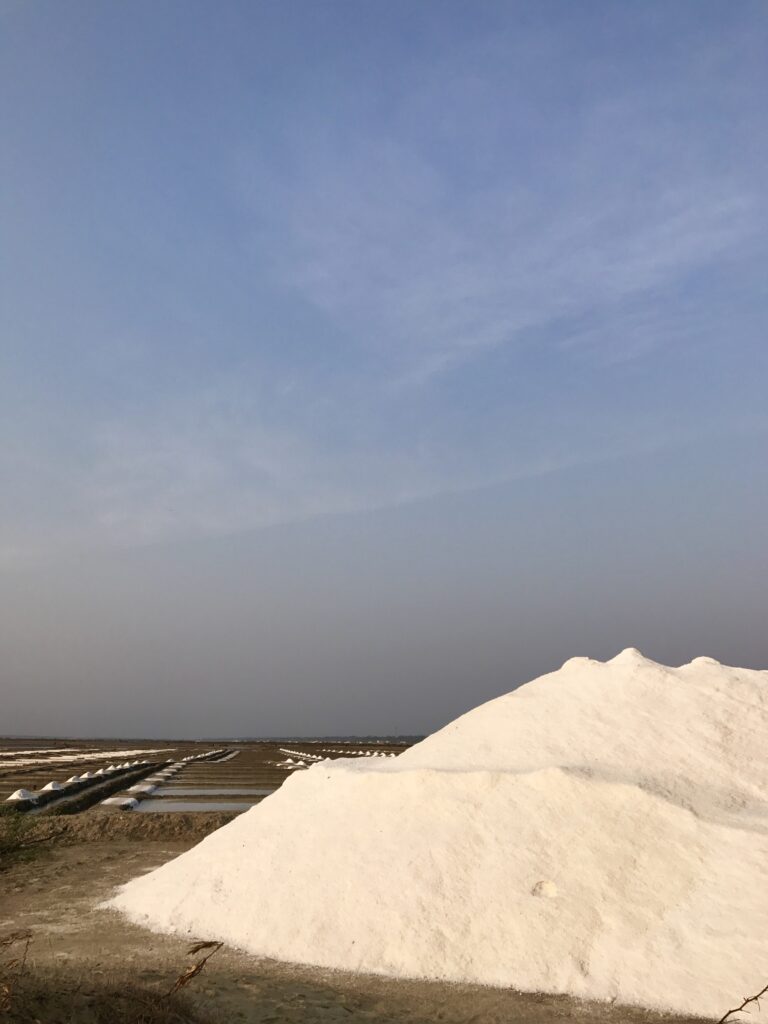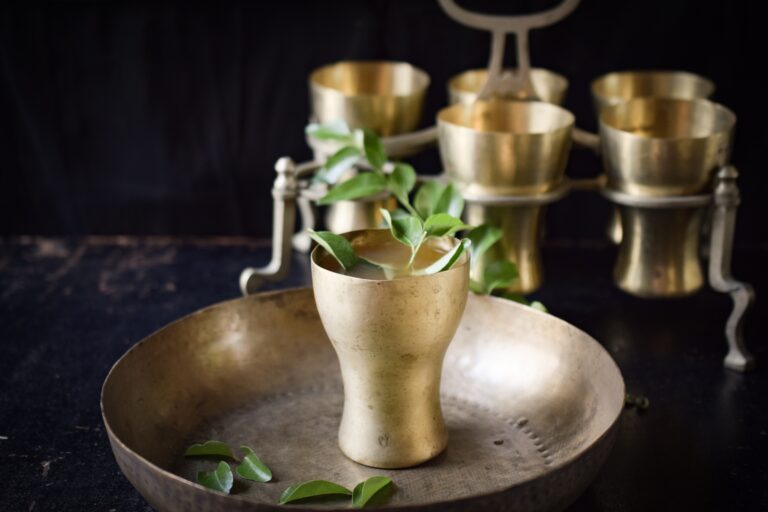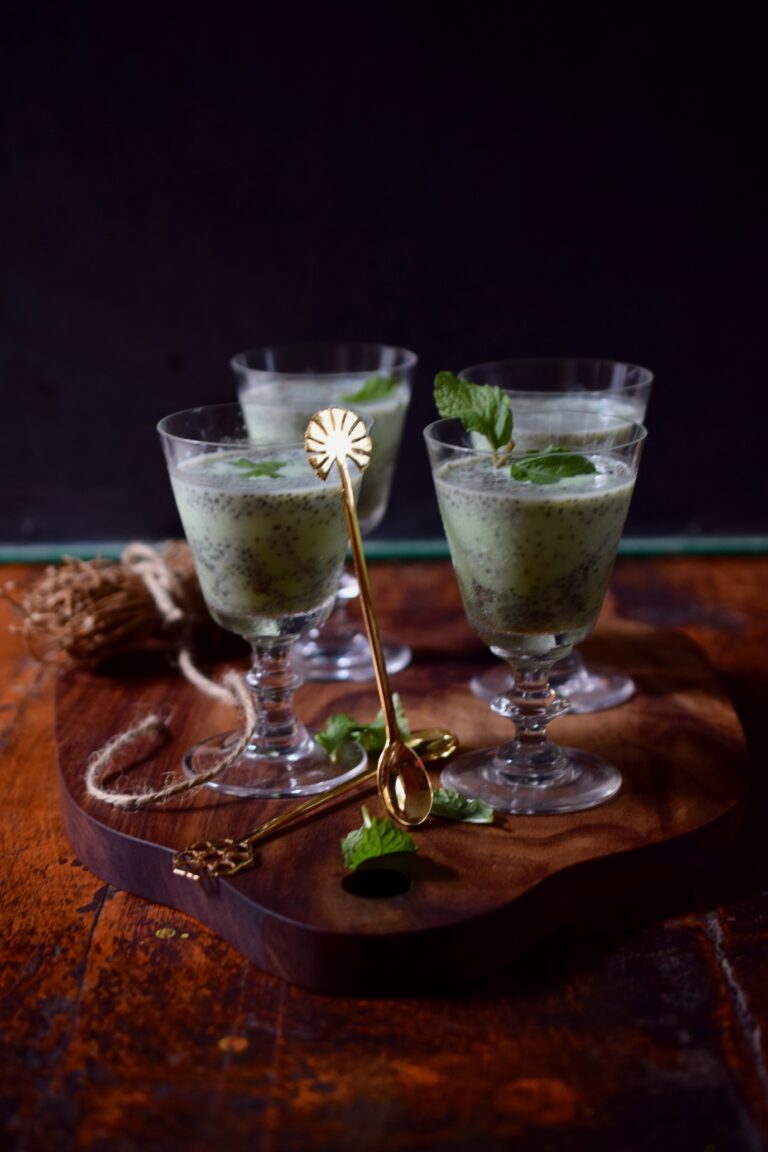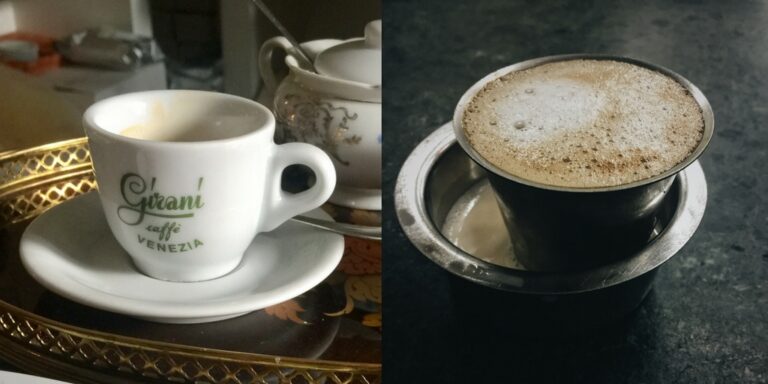When I was a little girl, the month of Aadi in Chennai meant music being blared from temple speakers and a general atmosphere of colour and sound on the streets. Just like with the funeral processions full of flowers and drumming, I thought all of it was pure celebration. Now, as an adult, I appreciate the nuances, but there is still something about this month that catches my eye – and more accurately, my sense of smell. For temples small and large through the city make ritual offerings to the Goddess, which are then distributed to all. The scent of freshly made koozh (pronounced koo-lu), a millet-based porridge, fills the air along with devotional songs.
Being born and brought up in Chennai into a traditional Gujarati home has given me a more expansive way of thinking, which is what opens one’s mind to explore. There are times when I think in Tamil while I’m cooking Gujarati food! Even as the world becomes a smaller place, I love keeping local culinary customs alive – but every once in a while, my imagination will take me on an adventure in the kitchen. So it was while making shrikhand one day, a sweetened Gujarati dish made of hung curd. I’d played with various Indian flavours for shrikhand before, including mango and an almond-saffron blend. But I had just met with a friend, Siddharth Murthy, who has an organic lavender farm outside Melbourne in Australia, and he had gifted me one of my favourite foreign ingredients. Next to rose, lavender is the scent I enjoy adding most to my cakes. I wondered: how would my family like to end a meal on lavender shrikhand?
There I was in the freezing cold of the Berkshire mountains in Massachusetts, USA, telling my friends and family back home that I was finally about to do for fun what I didn’t enjoy doing in school – study! I had given myself the gift of learning: specifically, the subject of Macrobiotics, a system of mindful cooking and eating. My classes at the Kushi Institute often took place in the snowy winters, and even from indoors the beauty of my surroundings inspired me every day. Chirping birds, beautiful trees, and a healing science drawn from the principles of Zen Buddhism… Which I brought back to my home in Chennai, with its own trees and birds and mouths to feed.
The very first recipe I learnt from my mother was the foundation of all Gujarati meals: the humble yet hard-to-perfect roti. Or as we call it, rotli. The ideal Gujarati rotli has to be as thin as muslin, and it took me years of practice to expertly knead the dough and roll it into perfect circles. My mother insisted that a good Gujarati girl’s rotis had to be dainty and delicate. My early ones often turned out like Punjabi parathas, large and thick – and by the norms of the Gujarati kitchen, totally wrong! Curious about this cultural difference, I asked a Punjabi neighbour why their standard for the perfect flatbread was so unlike ours, and she gave me a beautiful answer: the big Punjabi paratha reflects generosity, large-heartedness and the desire to share what you eat with the world!
Rotis, known by many names and variations, originated in the Indus Valley civilisation, where grain grinding is said to have been invented. Indian breads are different from other loaves in that they do not contain yeast. This soft form of unleavened bread comes in various forms, shapes, sizes and flavours typical of the region it is prepared, with flour made of millets, wheat, rice and other grains.
All over India, the basics of a good roti are flour, fat and flavour. The fat comes from oil, butter, cream or ghee. There are so many kinds of flavourings and stuffings – from green chilli paste to potato to cauliflower to the quintessentially Bengali renditions made with fish.
I’d like to tell you more about a few Gujarati variants: the herbed thepla, the crispy bhakri, the sweet puran poli, the seasonal juwar and bajri, and the simple rotli. Of these, I’ll share two recipes – both are meant to be eaten hot, and bear in mind that an average person can easily eat several at a time! Some notes for kitchens outside India: while binding the dough, I work with my hands. However, if you’re used to the food processor, please do utilise it. You can use a standard rolling pin.
Rotli

Lunch during our summer holidays as children was a competitive affair: who could eat the most rotlis? These rotlis were the simple, everyday variety, washed down with aam raas, a seasonal mango purée. A blissful siesta would ensue, the heavy lunch and the heat lulling us to sleep to the sound of old Hindi songs on the radio…
The rotlis we had then were made from balls of dough joined together, then roasted and peeled from each other. They were as fine as skin. We also ate a sweetened “children’s” version, made with jaggery water. Another way to sweeten a rotli, if you want to, is to eat it with a strained yoghurt dessert known as shrikand. I’ll be sharing a recipe for that soon, and if you subscribe to this blog, you’ll be the first to know.
Thepla
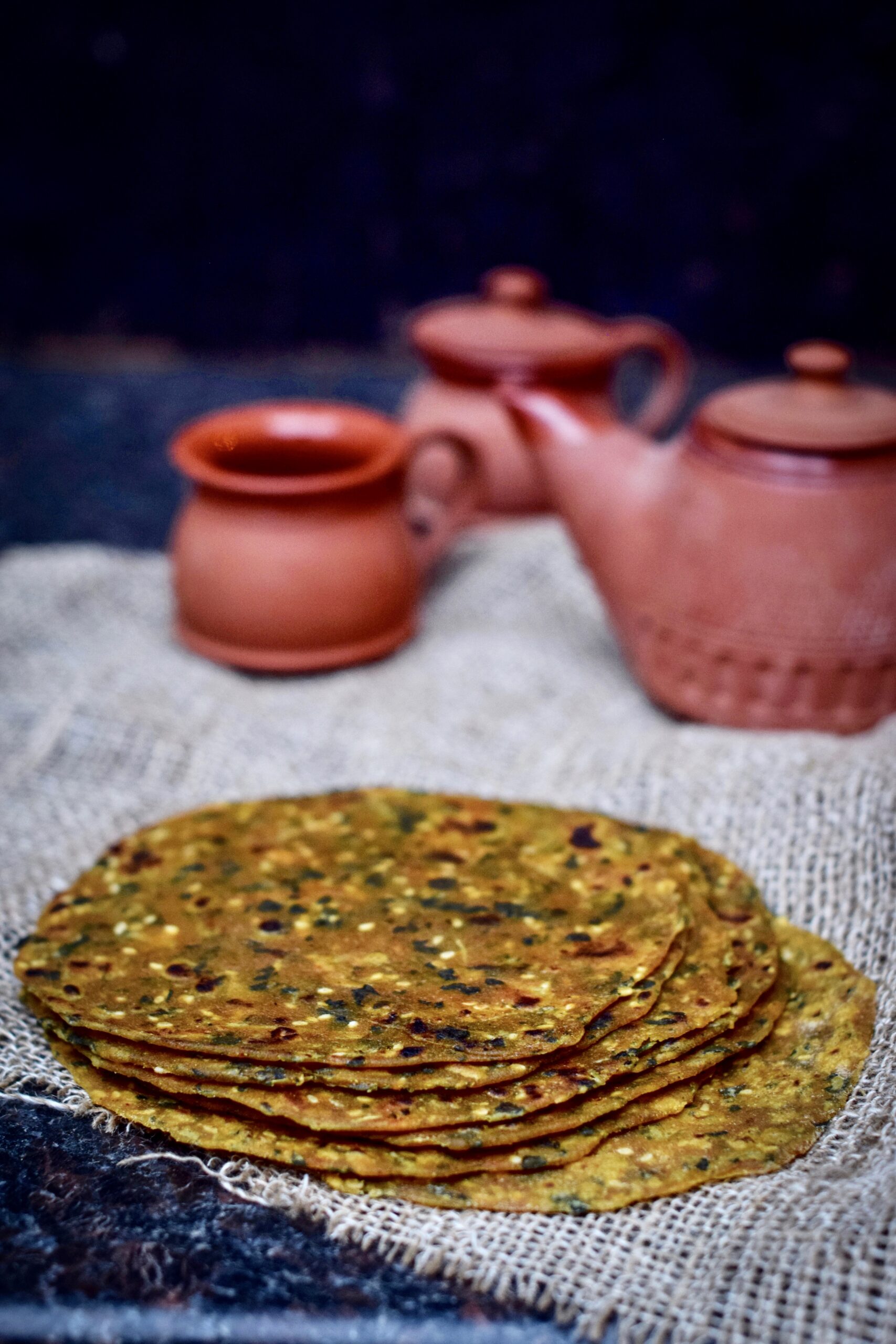
(Yields: 12)
1 cup methi (fenugreek) leaves, picked and washed
1 cup whole wheat flour
1 teaspoon salt
¼ teaspoon turmeric powder
2 teaspoons cumin powder
1 teaspoon white sesame seeds
1 teaspoon crushed green chili (adjust to your taste)
½ teaspoon ginger paste
1 tablespoon yoghurt
1 tablespoon sunflower oil + oil for sautéing
100 ml water or less
Traditionally, theplas are often made with leftover rice or khichdi, so as not to waste food, but you can make them fresh too. In a mixing bowl, add all the dry ingredients and blend them gently. Now add the 1 tablespoon of oil and the yoghurt. Slowly add water and continue mixing, until you feel the mixture is slightly tougher to the touch than bread dough. You do not need to use the entire 100ml.
Dust both sides of the ball with flour. Make small lemon sized balls and allow them to sit for at least half hour. Now, dusting more flour as you do, roll out the dough into discs. Make them as thin as you can.
On a heated iron pan, place the thepla on a medium flame for 30-40 seconds. Then turn it to the other side. In another 30-40 seconds, add a few drops of oil. Make sure the oil is spread to the edges too, as the thepla may dry out. Press down with a spatula to help it cook. Flip the thepla a couple of times until it is golden on both sides. Remove from the pan and fry the next disc, and so on.
As you make each thepla, either store it in a hot case, so it remains soft and warm, or pile them up on a plate. Serve hot, with a curry of your choice or a sweet mango or kumquat pickle, or simply enjoy them as some Gujaratis do – with a lovely cup of chai.
Bhakri

(Yields: 15)
2 cups whole wheat flour
¼ cup semolina
¼ cup oil
100 ml warm water
¼ teaspoon salt
A bhakri is really a type of biscuit, made with a greater quantity of oil than water. A version with jaggery water was my standard after-school snack while growing up. You can make this in the sweetened (what I call “children’s”) version too, by substituting plain water for jaggery water.
Assemble all the ingredients in a large bowl. Add water slowly as required and bind the dough together. Continue pressing firmly, until it all comes together and does not stick to the bowl or your fingers. The dough should appear as a smooth, firm ball. There’s no need to dust this ball of dough with flour, as it is quite tough and will not stick while rolling. If it does stick, you have probably added more water than required, and only in this case should you dust a little flour. Now, divide the dough into 15 smaller balls and keep aside.
Heat an iron pan. Roll out the dough into discs of about 1 cm thickness – this is where the thin-as-muslin standard doesn’t apply! Place the discs onto the hot pan and reduce the flame. Since bhakris are thicker they need to cook on the inside too, so it will take longer to cook. The flame needs to be maintained between medium and slow. Flip over each bhakri a couple of times until golden. If you’d like to, use a pair of tongs and roast the bhakri directly over the flame towards the end of its cooking time. This is the traditional way – dough to flame, directly, just like in this video!
Once they are crisp and golden, remove from the pan and let a trickle of ghee melt onto the bhakri. Serve with tea. They also travel well, so consider packing them for journeys. As my mum would say, a well-made bhakri will be like an easily chewable cookie – it can be eaten comfortably both by the elderly and by children alike.
Puran Poli

Sweet, stuffed and festive, the puran poli is enjoyed not just in Gujarati cuisine but throughout India. Made of toor dal (pigeon pea) and jaggery, it is a stuffed and folded variant that is half-roti, half-dessert.
Juwar & Bajra

It’s only after years of practice with the other rotis that one comes to seasonal variants like juwar and bajra, which are even more difficult to make, let alone master. Gluten-free, the juwar roti is made of sorghum flour while the bajra roti is made of pearl millet. These thick flatbreads were traditionally eaten during winters, roasted on a charcoal flame and thus imbued with a different flavour. They were most often relished with a thick layer of white home-churned butter and sugar or jaggery. Leftover juwar and bajra make delightful, healthy cereal when crushed and eaten with milk.
*
Many Gujarati rotis were created to satisfy two specific purposes: to suit the extremely dry summers and cold winters, or to be travel-friendly, a fact proven all the way from the traders of yore to families like mine who took cross-country train rides. Whether unpacked during a picnic or a road trip, or eaten fresh and piping hot from the stove, the roti satisfies.
Throughout the subcontinent, we eat with our hands. According to Indian philosophy, the 5 senses are at our fingertips, and the act of eating activates all of them. Eating is truly a multi-sensory experience: presentation, ambience, mood and texture (even the texture of the thaali or plate – is it silver, terracotta, bell-metal or steel?), who serves us, who we eat with, the memories we recall or create through the meal – all of these matter as much as the taste itself.
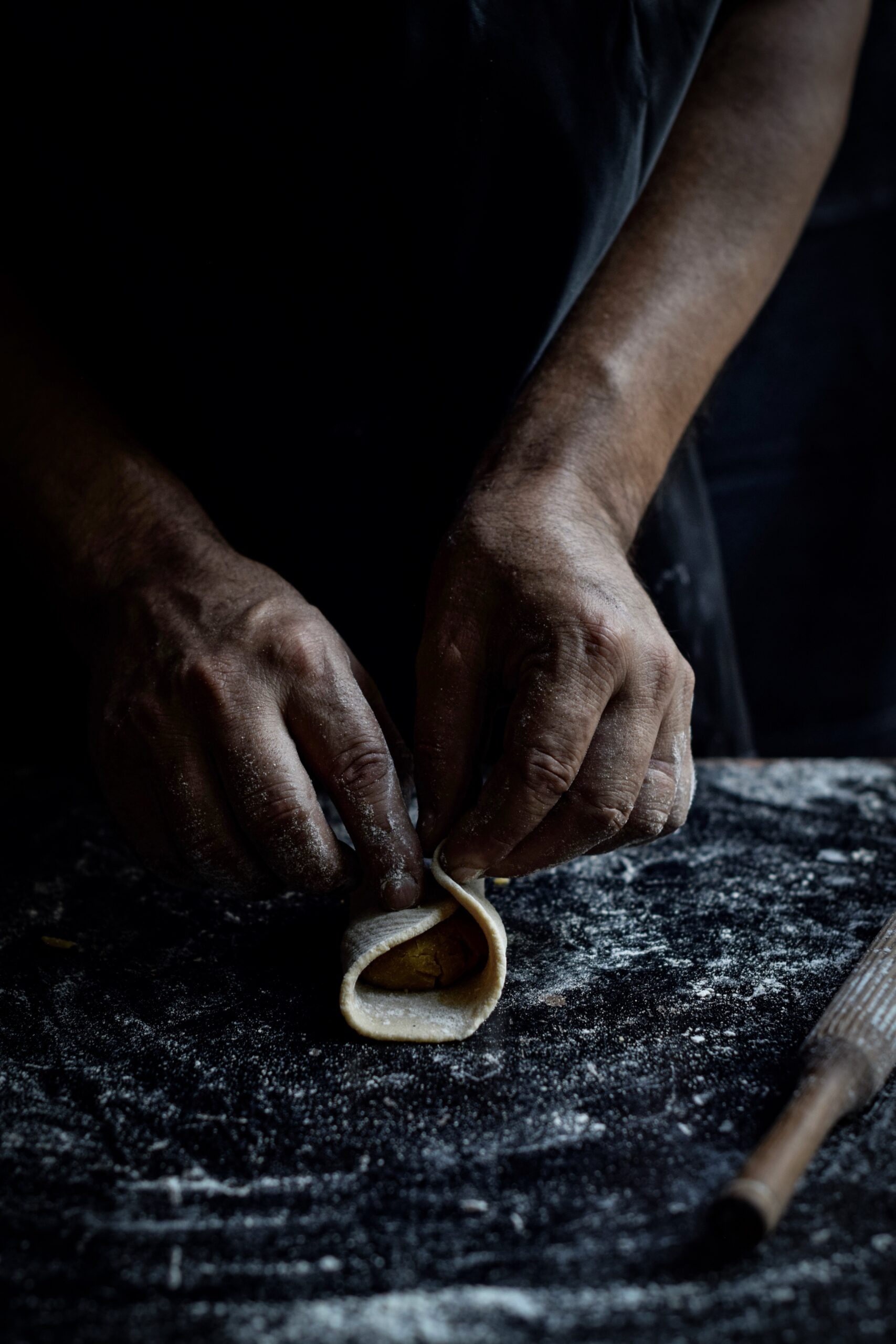
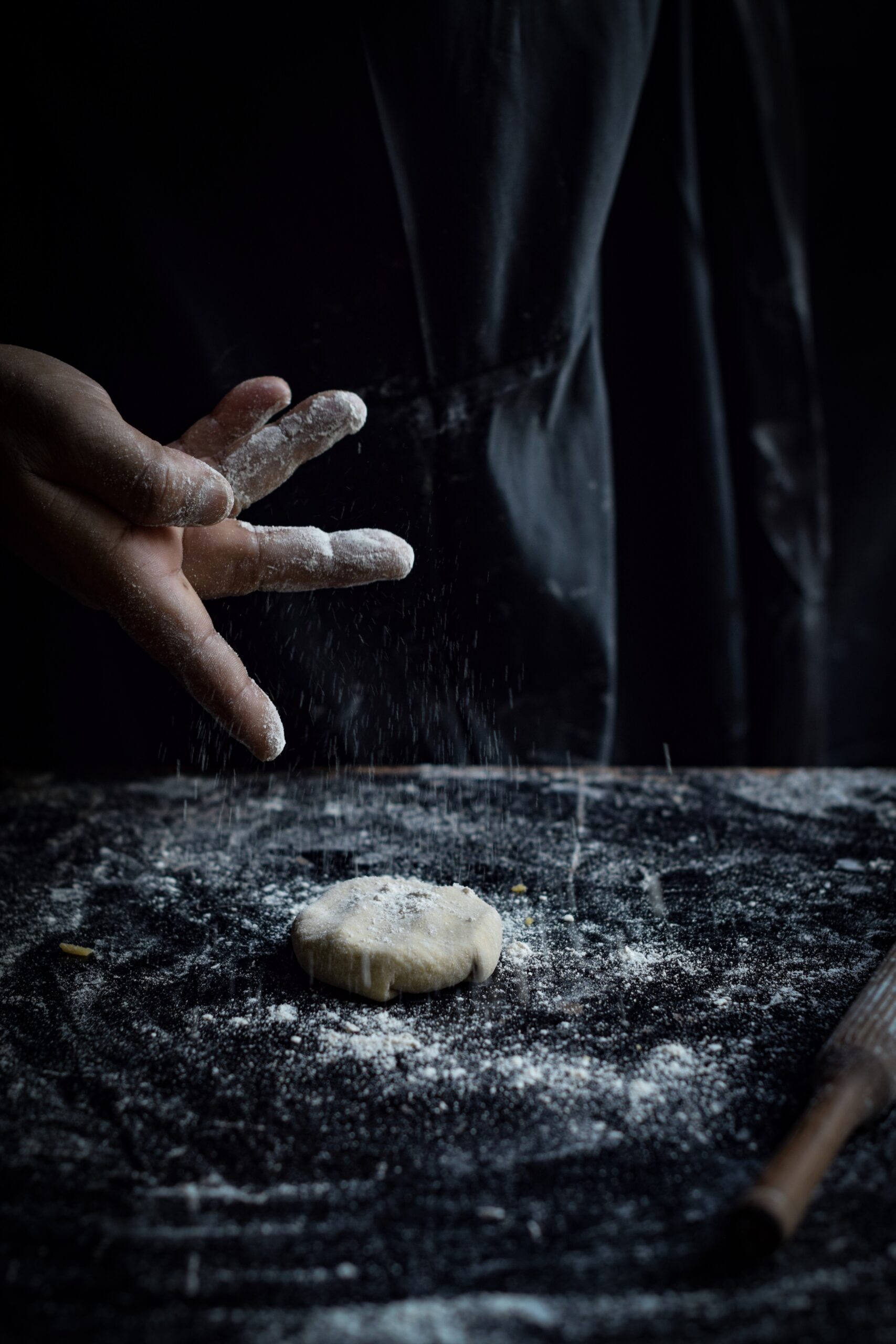
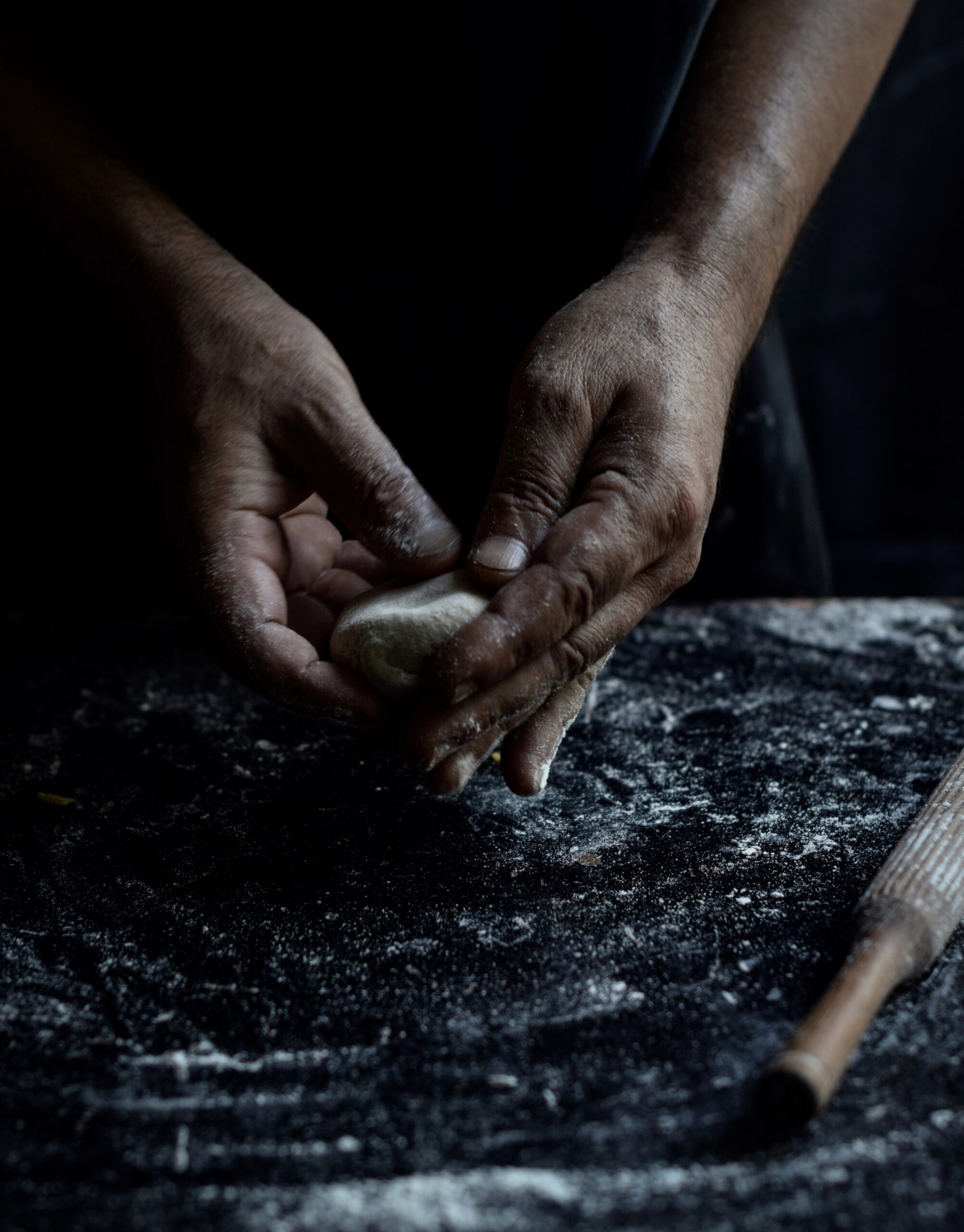
When I was a girl, the full moon known as Sharad Purnima, marking the end of the monsoon, was a special occasion among a group of close family friends, who would enjoy the evening by the beach. The parents would chat as the kids played in the sand on Marina Beach, which was then pristine and beautiful! These outings were special as they created a special bond within the Gujarati community in Chennai.
So my earliest memories of kheer are to do with these nights, when my mother always carried her dudh-poha (beaten rice) variation, soaked soft in milk. Dudh-poha kheer is a customary Sharad Purnima dessert. There was such simplicity in that dish, yet how fantastic it tasted! Even now, it takes me back to those nights. I distinctly remember the almost silver sands and the beautiful moon reflecting upon the sea, and how we kids ran about and were warned not to go into the sea to wet our feet, for the waters were choppy and full moons always cause higher tides. We marvelled at the waves from a distance, all the while waiting to be called to have our cup of kheer. I remember the excitement of waiting the entire week for this outing as my mother called the other aunties to make the plan.
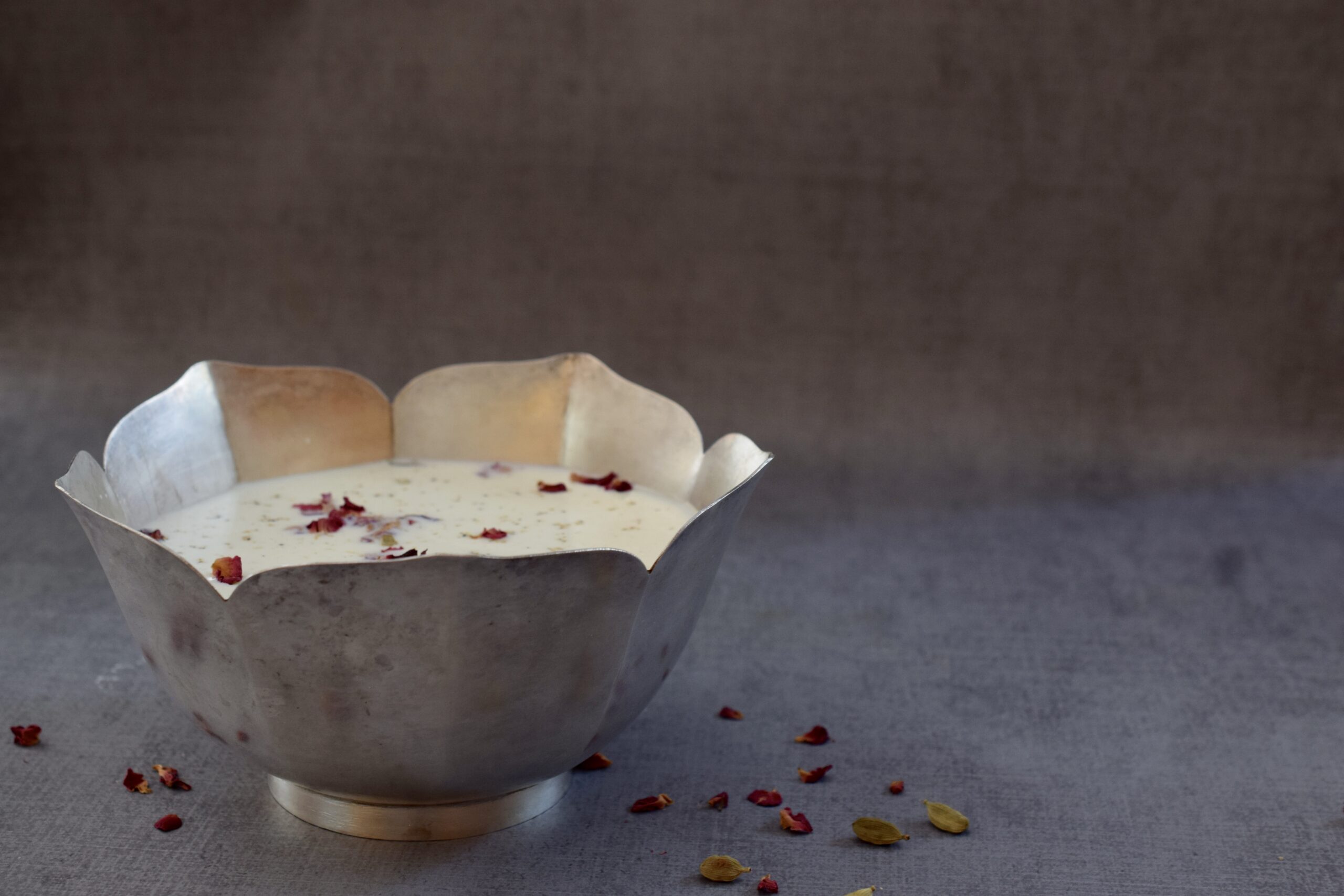
Kheer is basically an Indian rice pudding, with variations across the subcontinent. In South India, it is known as payasam, and is made using a number of different recipes with ingredients as wide-ranging as jaggery, vermicelli, sago, coconut, carrot, ghee and jackfruit. A Hyderabadi version even uses bottle gourd. A sweetened, spiced North Indian version rich with nuts, enhanced with rose water, is known as rabri.
Significantly, the old and infallible combination of milk and rice has traditionally been used as a ritual offering in Hindu customs. The practice is that food both cooked and uncooked is served to the Gods, thereby rendering it holy. It is then distributed to all present as blessed food, and is known as prasad or prasadam.
Kheer is so simple, yet profound, which is why it is so popular both as a prasad and as a regular treat: rice contains life within itself, while cow milk is considered sacred. Sugar, of course, is what turns many a dish into a dessert.
My mother’s kheer was sheer simplicity, but also sheer perfection: poha, milk and sugar with a pinch of cardamom. The one I will pass on to my children, and which I am so delighted to share with you, is almost as simple – but with that signature re:store touch.
Rose-Coconut Kheer
(Yield: 8-10 cups)
½ cup basmati
4 cups whole milk
¾ cups sugar
1 cup freshly squeezed coconut milk
2 tablespoon coconut shavings
½ teaspoon cardamom powder
2 tablespoons rose water
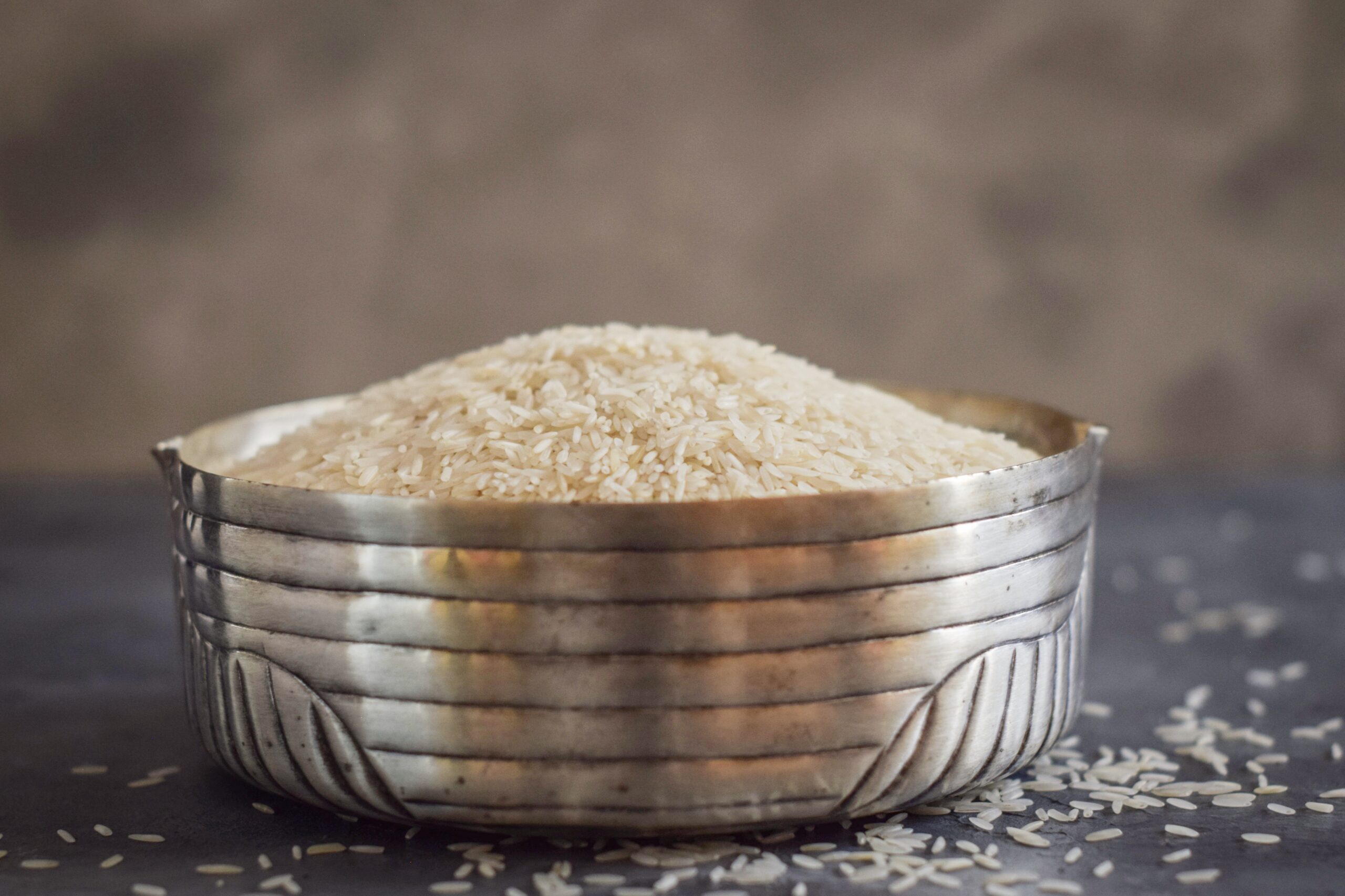
Basmati rice is the long-grained aromatic variety commonly used in biryanis and pulaos. Soak the basmati in water for half an hour. This will help the grain cook faster.
In a heavy-bottomed pan, add the milk. Once it is warm, add the soaked rice. On a low flame, allow the rice to cook thoroughly, stirring frequently to ensure it doesn’t stick to the bottom of the pan. This will take approximately 45 minutes.
Now add the sugar, then allow it to cook a little more. Let the rice mixture cool slightly, then very gently hand blend it. Cover the saucepan and allow the mixture to cool to room temperature, then refrigerate.
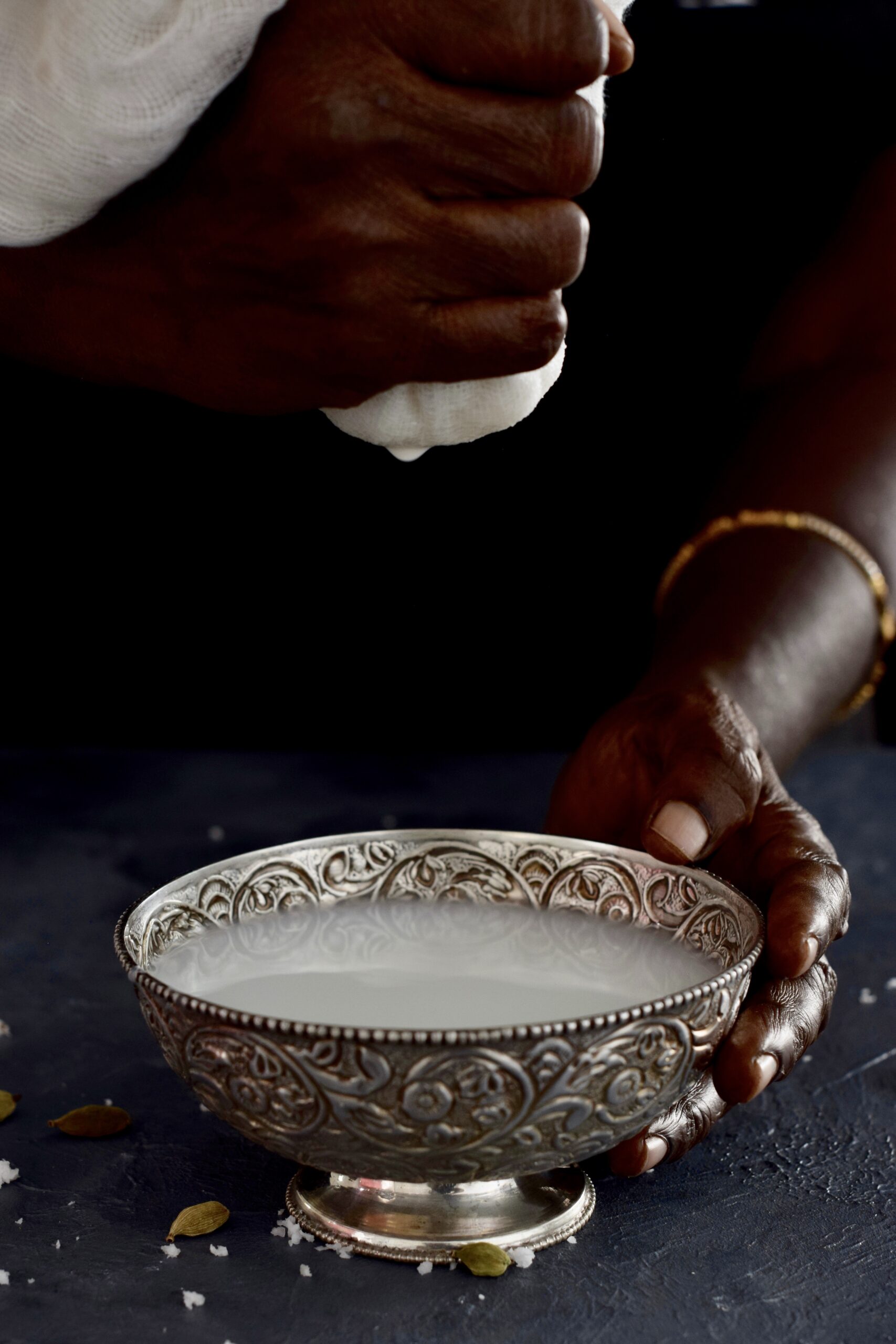
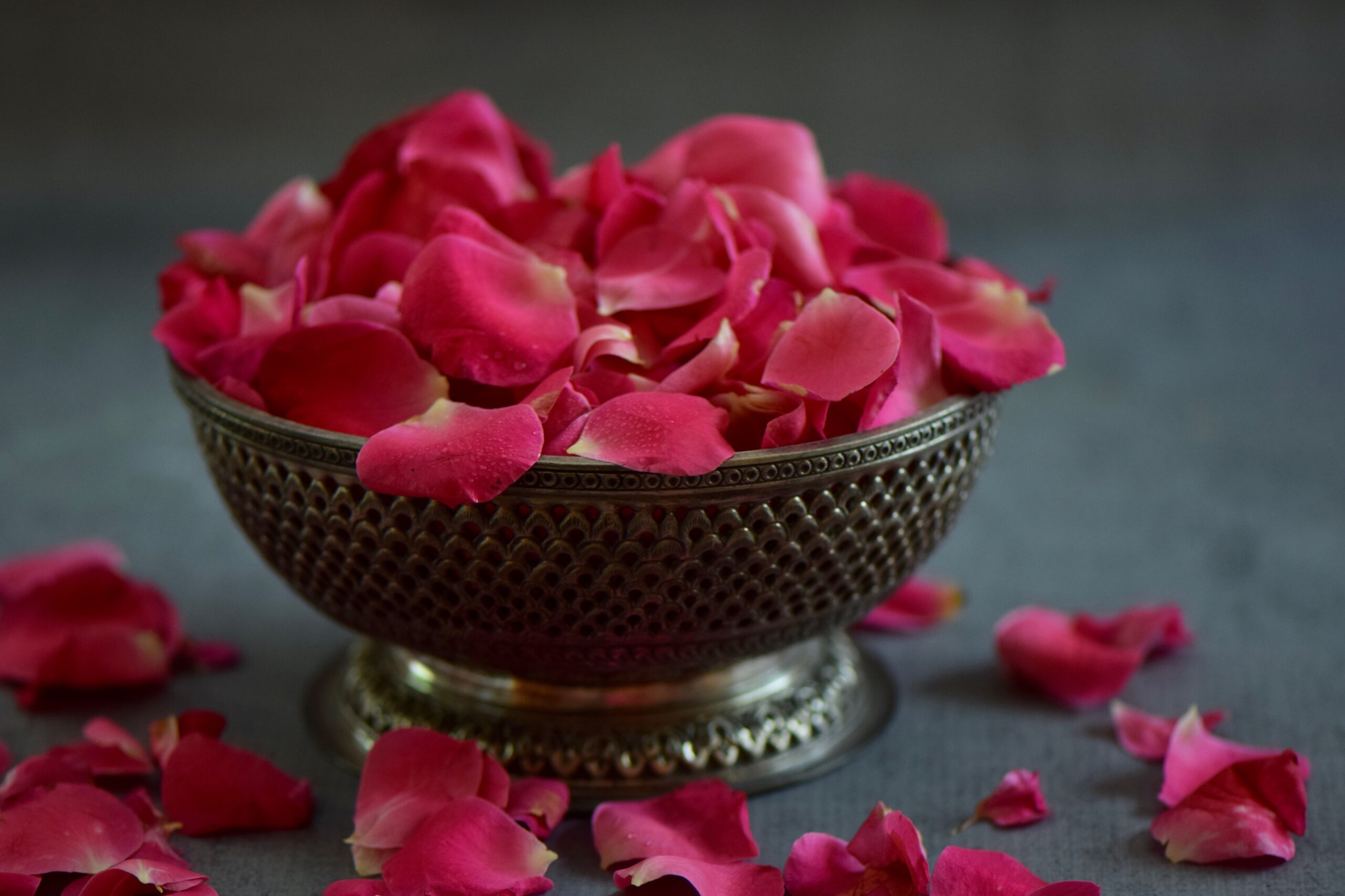
When the kheer has cooled and thickened, add the coconut milk to your desired consistency. Add the shaven coconut, rose water and half the cardamom powder and stir so that the flavours are well-blended. Rose water is a signature ingredient in many of my cakes at re:store, because the scent reminds me of one of my favourite flowers. Known in South India as the paneer roja, the damask rose inspires many of my innovations in the kitchen. The Mughals brought roses to India, as seen in the Shalimar gardens. They were distilled as much for their fragrance as for their usage in culinary delights like syrups and sweetmeats.
Cover and refrigerate until serving. When you are ready to serve this dessert, you may wish to add more coconut milk. Don’t forget to sprinkle the remaining cardamom powder to decorate.
Nostalgia is what makes our food special. Each family recipe is special only to them because it is intertwined with memories. Memories and love: the two main ingredients of any recipe. Today, my best dishes are those that my mother taught me and some that I learnt from my mother-in-law. Some day I will pass these on, too – along with my own innovations. I have made several promises to visit my children when they have their own families to go cook for them. It’s funny how when I cook, my children relish the dishes and claim they are “finger-licking good”. But when our cook makes the same dishes, they are simply edible or enjoyable. So much of taste is through what is evoked emotionally. So whenever you try a new recipe in your kitchen, remember that it is going to become a mnemonic too. Fill it with love.
As I write this, the month of Ramadan is coming to a close. All over the world, sweets are an integral part of the iftar customs when the day’s fast is broken at dusk. In India, iftar meals are almost always accompanied by kheer. At sundown, after the fast-breaking prayers, people step out to enjoy the breeze and socialise, visiting sweetmeat shops to enjoy their favourite Ramadan delights. Street food also becomes very exciting at this time, and the air is thick with the smells of delicious treats and an ambience of love and celebration. I love the idea that kheer is being enjoyed all over the country today – and perhaps in your home too, wherever you are in the world. Don’t forget to drop a line if you enjoy this recipe!
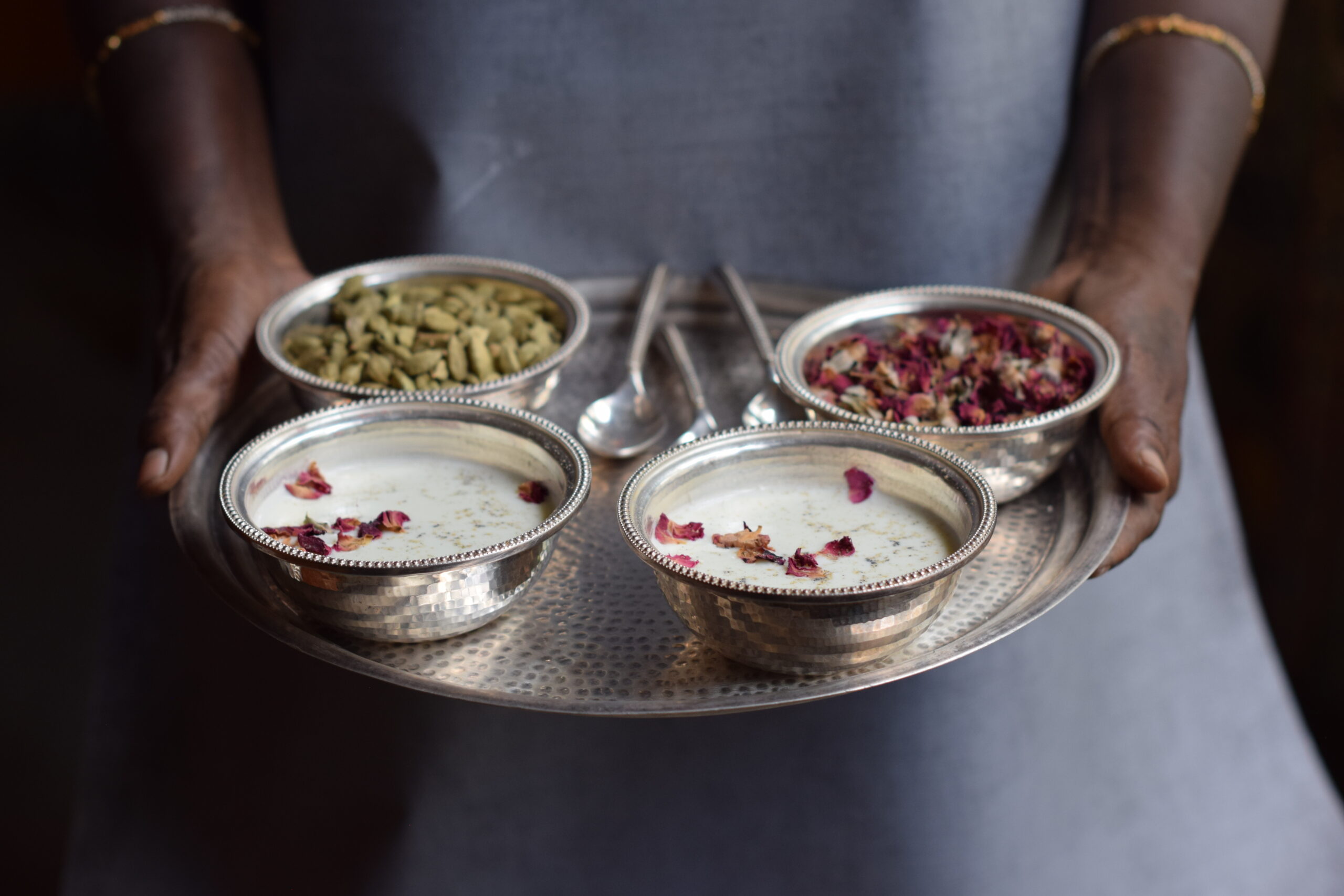
Having lived in Tamil Nadu my whole life, the traditional local cuisine has always been a part of me. Millets were a staple in ancient times, replaced more recently by rice and wheat. Unlike what most contemporary nutritionists believe, Macrobiotics suggests that rice, in moderation, does not have negative effects on health. Adding millets into one’s diet, as a healthy alternative or addition to rice, can boost the health quotient without compromising on taste. More importantly, millets are gluten-free, offering a great solution for those who are gluten intolerant.
Nowadays, the health-conscious hark on about quinoa, which is a great superfood – however, it is not native to India. They tend to ignore the affordable local millets, which offer the same (if not a greater) amount of nutrition and could themselves be superfoods!
“Do you know a cure for me?”
“Why yes,” he said, “I know a cure for everything. Salt water.”
“Salt water?” I asked him.
“Yes,” he said, “in one way or the other. Sweat, or tears, or the salt sea.”
These words from Seven Gothic Tales, the first book by the Danish writer Isak Dinesen (best known for Out Of Africa), came to mind on that mirage-filled drive to Marakkanam in the South Indian summer heat. Anyone who has ever driven from the metropolitan hub of Chennai to the quaint former French colony of Pondicherry along Tamil Nadu’s East Coast Road has noticed Marakkanam. Even if you do not know the village’s name, it’s impossible to miss the great heaped mounds of white salt glistening under the sun, lining the highway.
Salt. That condiment so precious to humankind that it has even been a form of wealth, measured at different times as either taxes or wages. The ancient Romans had a “salarium” (“sal” – “salt”), as part of a worker’s remuneration, as people were paid partly in salt. This is where the English language gets both the word “salary” and the idiom “worth his salt”. Closer to home, the monarchs of the Chola dynasty demanded a salt tax, known as “uppayam”. The historian Ramachandran Nagaswamy has spoken of epigraphic evidence showing how the same was paid from Marakkanam, making the salt industry in this village both an ancient and continuous activity. In modern Indian history, Gandhi’s salt march on March 12 1930 was a dramatic turning point in the independence struggle. In protest of the unfairly high British salt tax, he led the march from Dandi, Gujarat, to the Arabian Sea. There, he declared that a symbolic handful of sea salt would bring the end of colonial rule.
That afternoon, unlike so many journeys on that highway, I careened off the beaten path and entered the sprawling salt pans of Marakkanam to find out more….
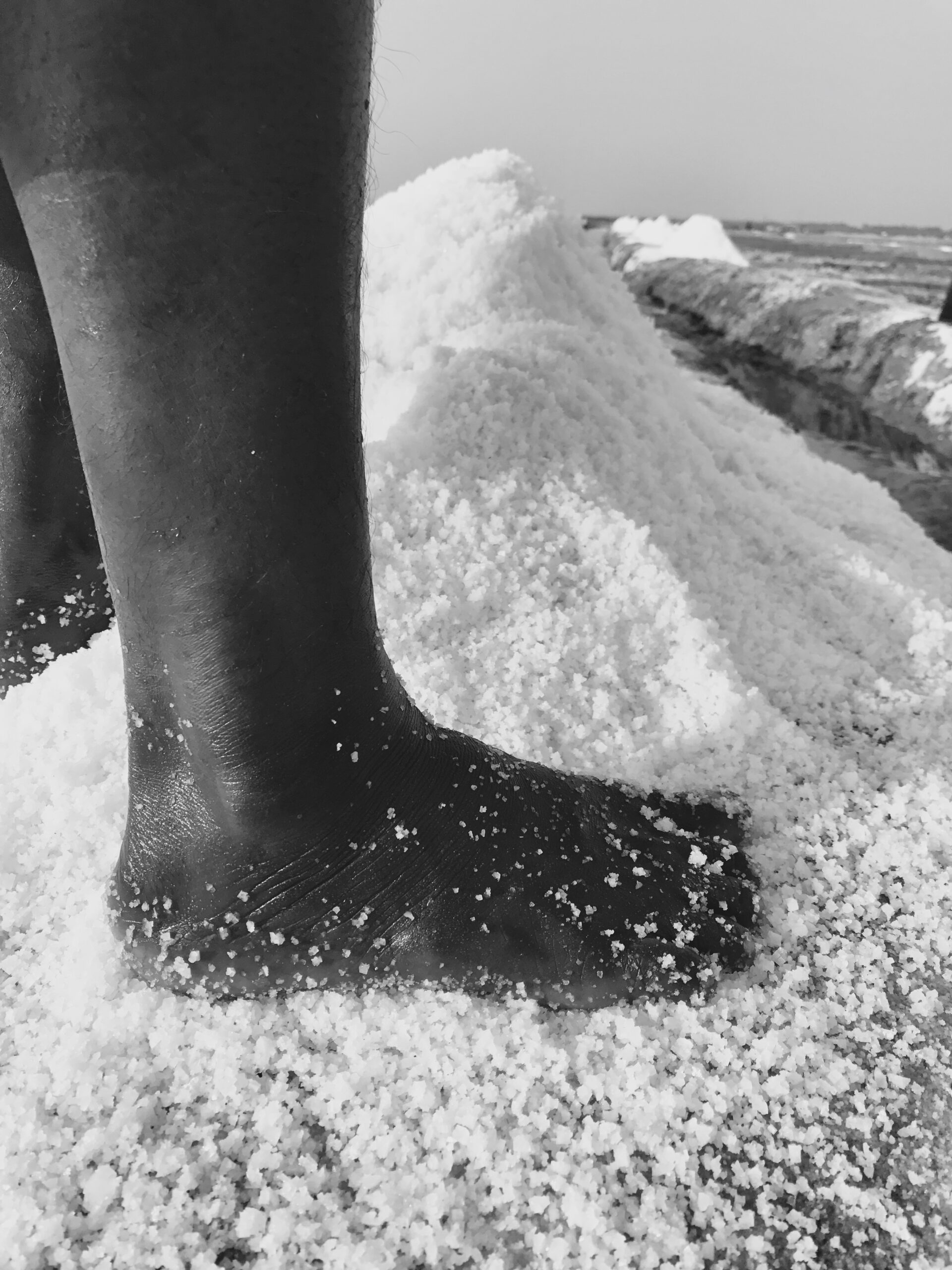
Salt. The most quintessential of all ingredients. So quintessential that we take it for granted. So quintessential that its absence alone can strip a dish of all taste. Saltiness is one of the five basic human tastes.
I’ve said before that curiousity is the cornerstone of every interesting kitchen. But it cannot end simply with flavours and ingredients. When I trained in the culinary science of macrobiotics at the Kushi Institute, I honed this need to know and to ask questions, because every single thing you put into a dish carries its own energies and its own properties. So what does salt contain? The scientific answer is that it is a mineral which contains sodium chloride (NaCl). In Marakkanam, I searched for a deeper answer by talking to people whose livelihoods are to harvest it.

That afternoon, I was fortunate to meet P. Nallathamby, a supervisor of a 3500 acreage of salt pans staffed by 2000 workers. I caught them during their second shift of the day: they rise early and work from 6am to 9am, then return at 1pm to continue. Both women and men work the salt pans. Mr. Nallathamby has been in this line of work for 40 years, having joined his father and brother in the same at the age of 18. But things have been difficult in the salt business for around 8 years, owing to various reasons such as rising diesel prices, increased labour costs and neglect from the central government, which leases out the pans to individuals.
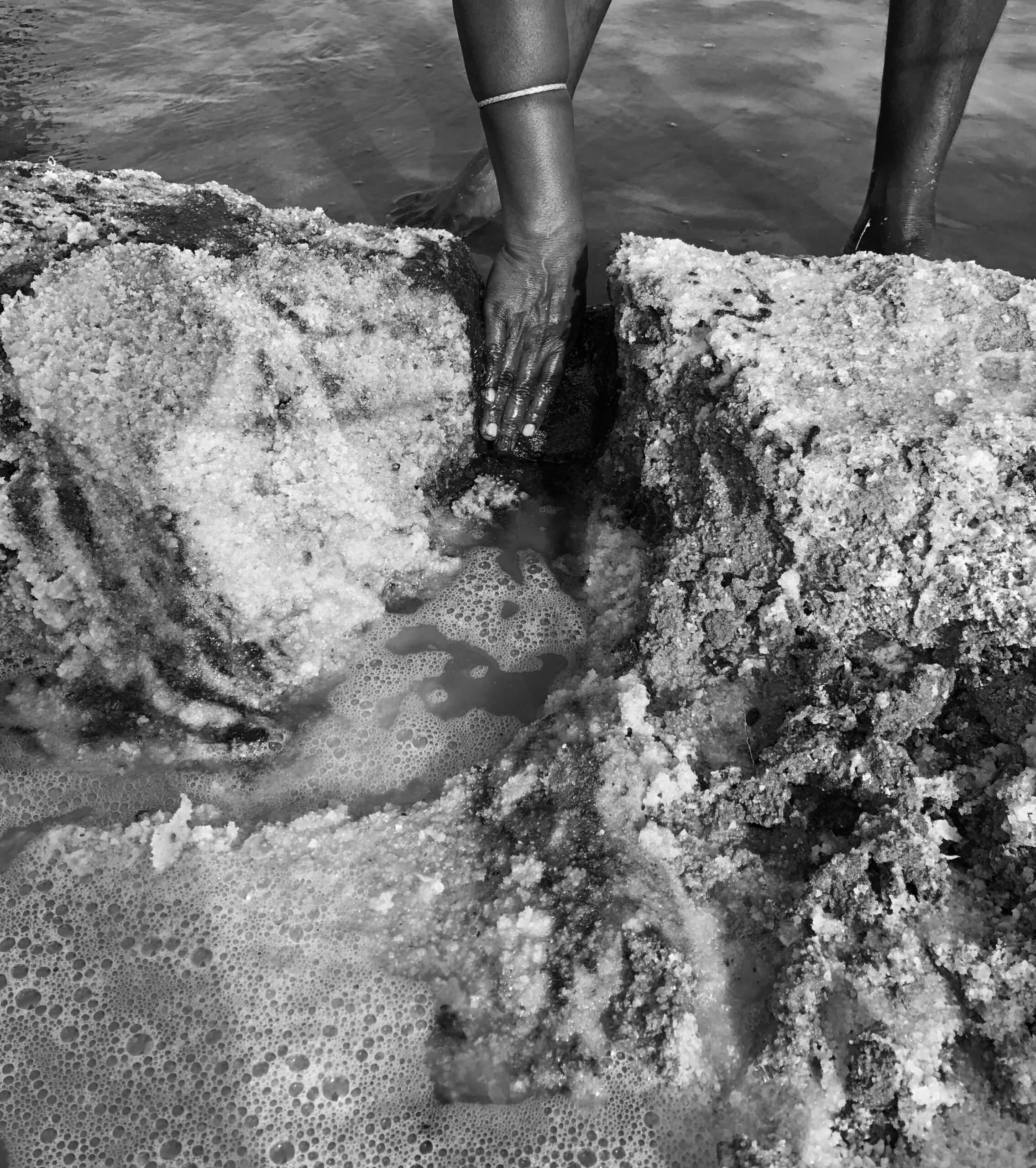
The harvest season runs from January to May. In January, the salt pans are like a lake owing to recent rains. It takes about a month to dry out, then the harvest begins. Every three days, the flats are scraped, as you can see in this video, and the photographs below.
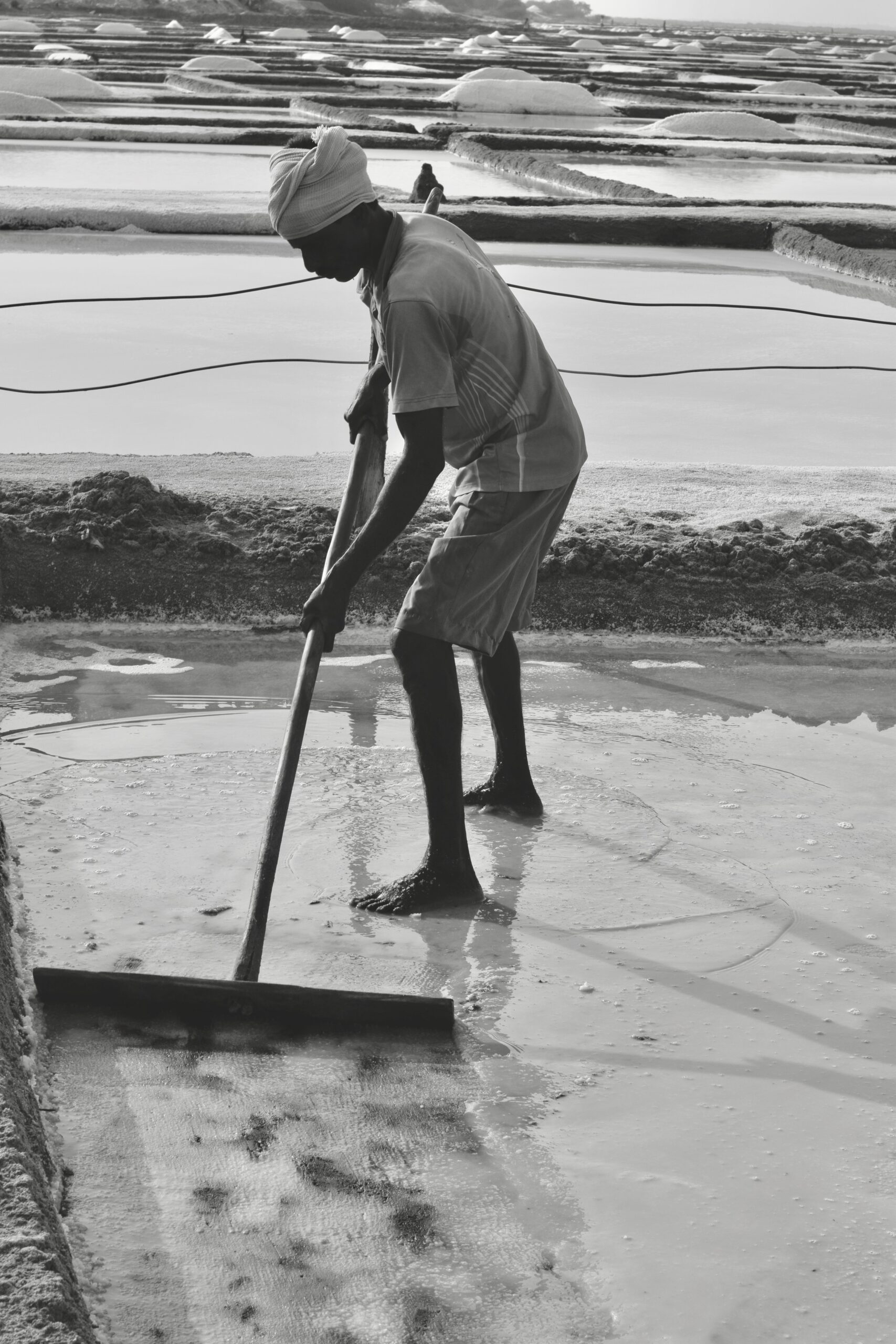

The salt is collected in small mounds along the grids of the pans, then in the huge mounds that are visible from the highway. Water from the earth or sea is added to the pans as necessary, such as between April and May. The process is entirely water-dependent, but ironically, no work can take place during times of rain. The mounds of salt wait for the daily lorries that come to purchase and take them away to be traded not just in Tamil Nadu and Pondicherry but in Kerala, Andhra Pradesh and Karnataka too. You may be surprised to know that a whopping 110 kilograms of salt is sold for just 130 rupees (approximately USD$2).
Mr. Nallathamby describes his 40 years in this line of work as uneventful. Even the great tsunami of 2004 did not have a negative effect on this coastal business. For six or seven months every year, the salt pans thrive. After all, come rain or shine, it’s an ingredient the world cannot do without.
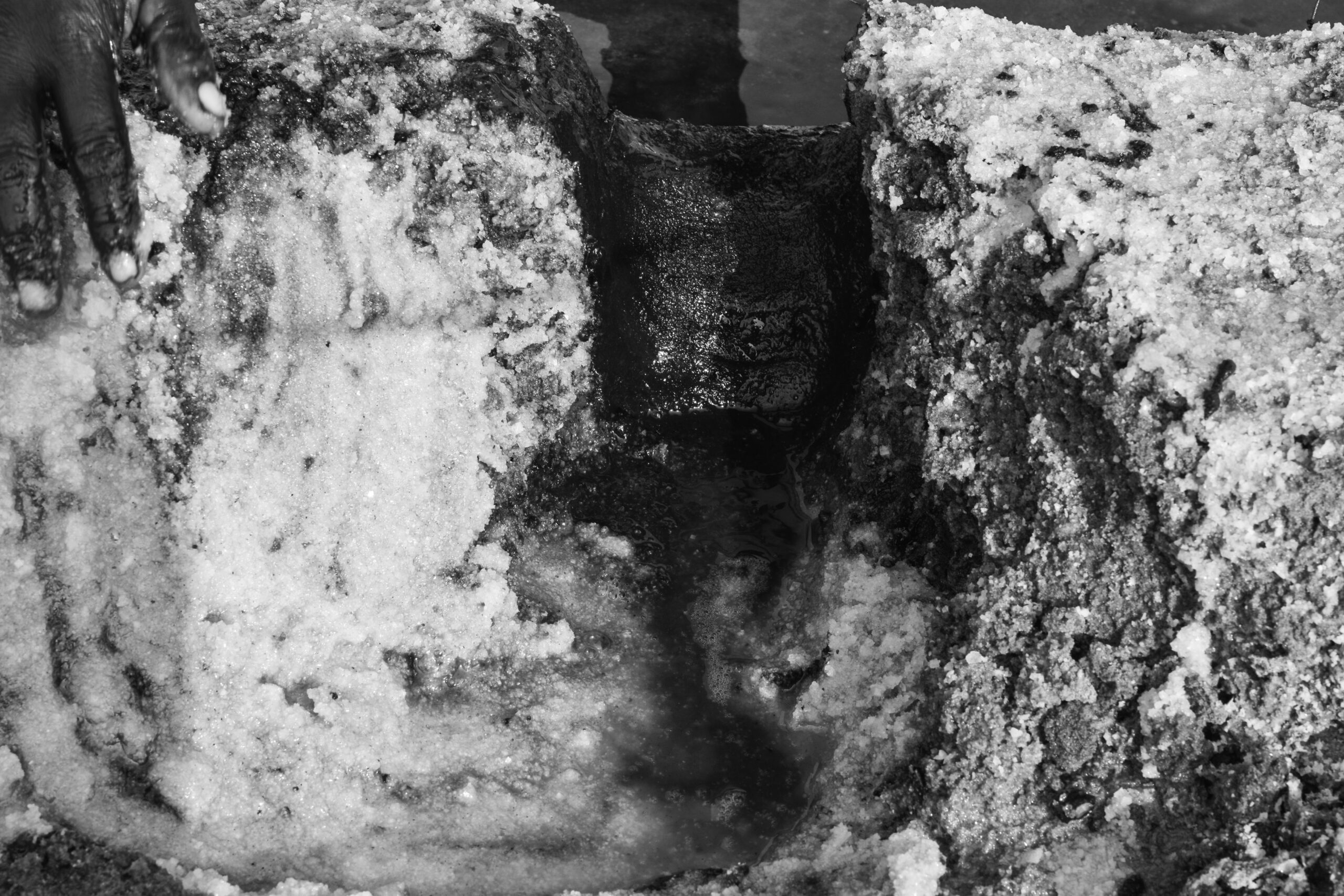
In Marakkanam, it is rock salt (which is not to be powdered) that is harvested. As you may remember from this recent summer-friendly recipe, rock salt contains many nutrients and works well as a digestive.
The salt pans of Marakkanam are quite amazing to behold: a contrast between grains so small and a landscape so large.
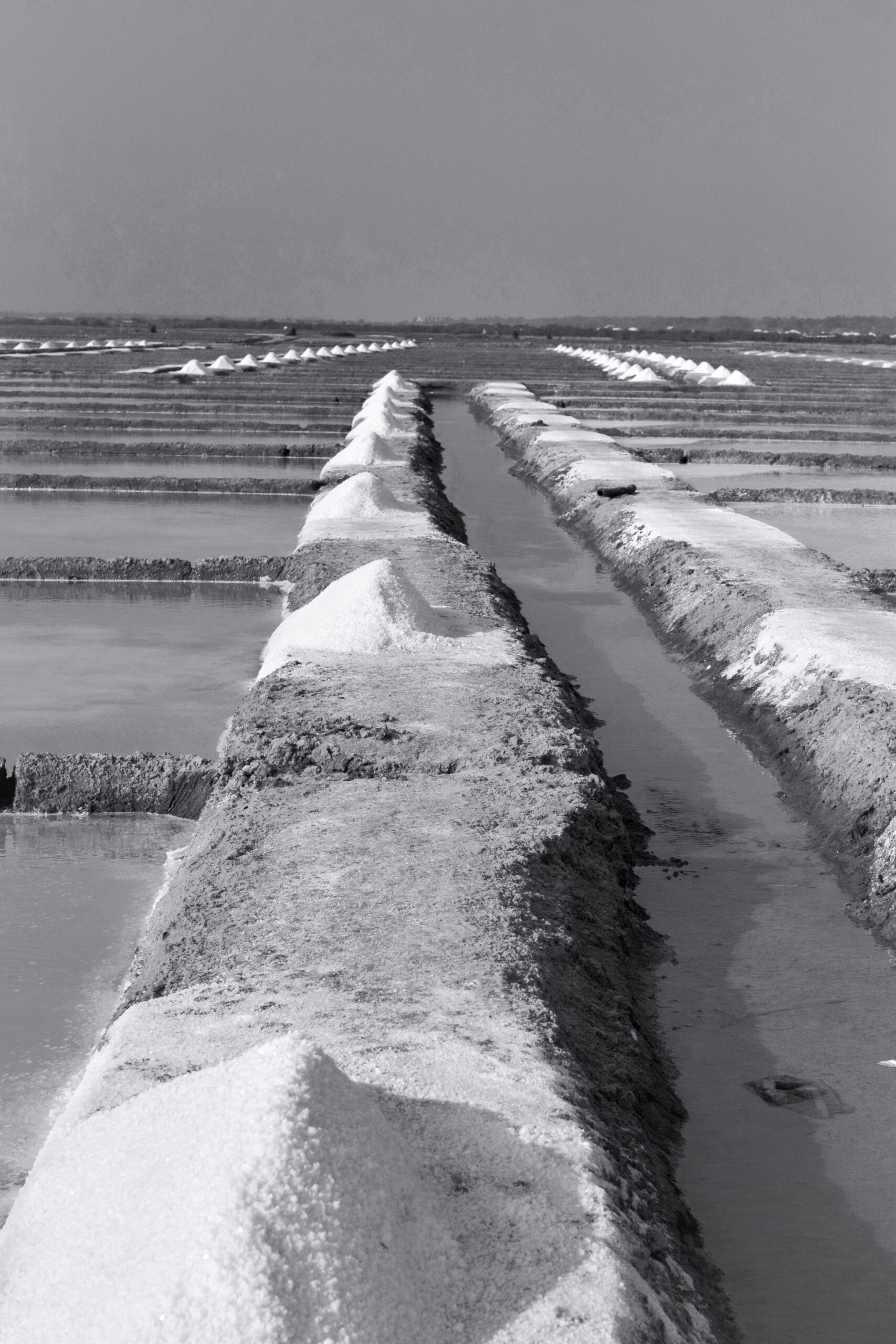
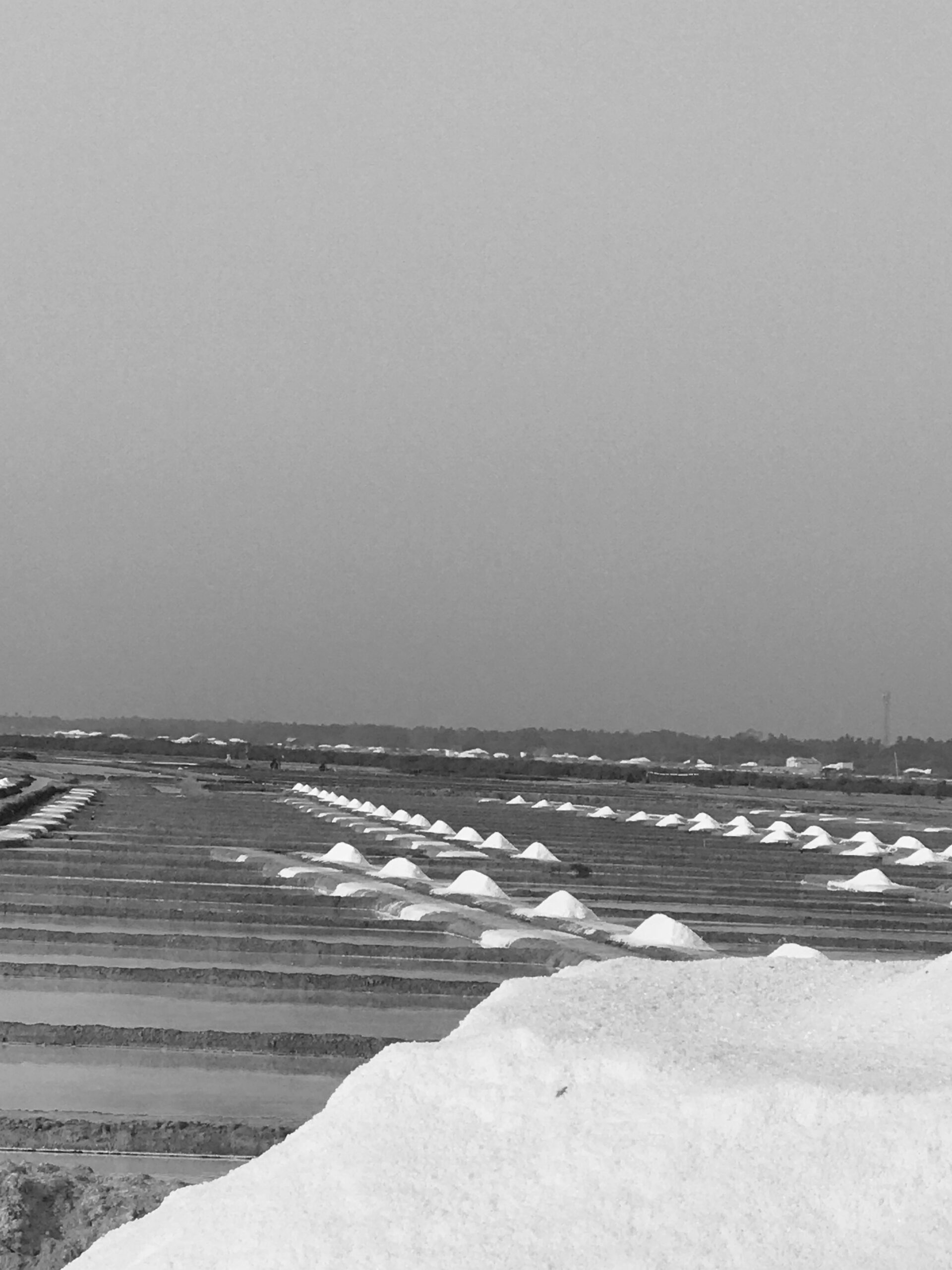
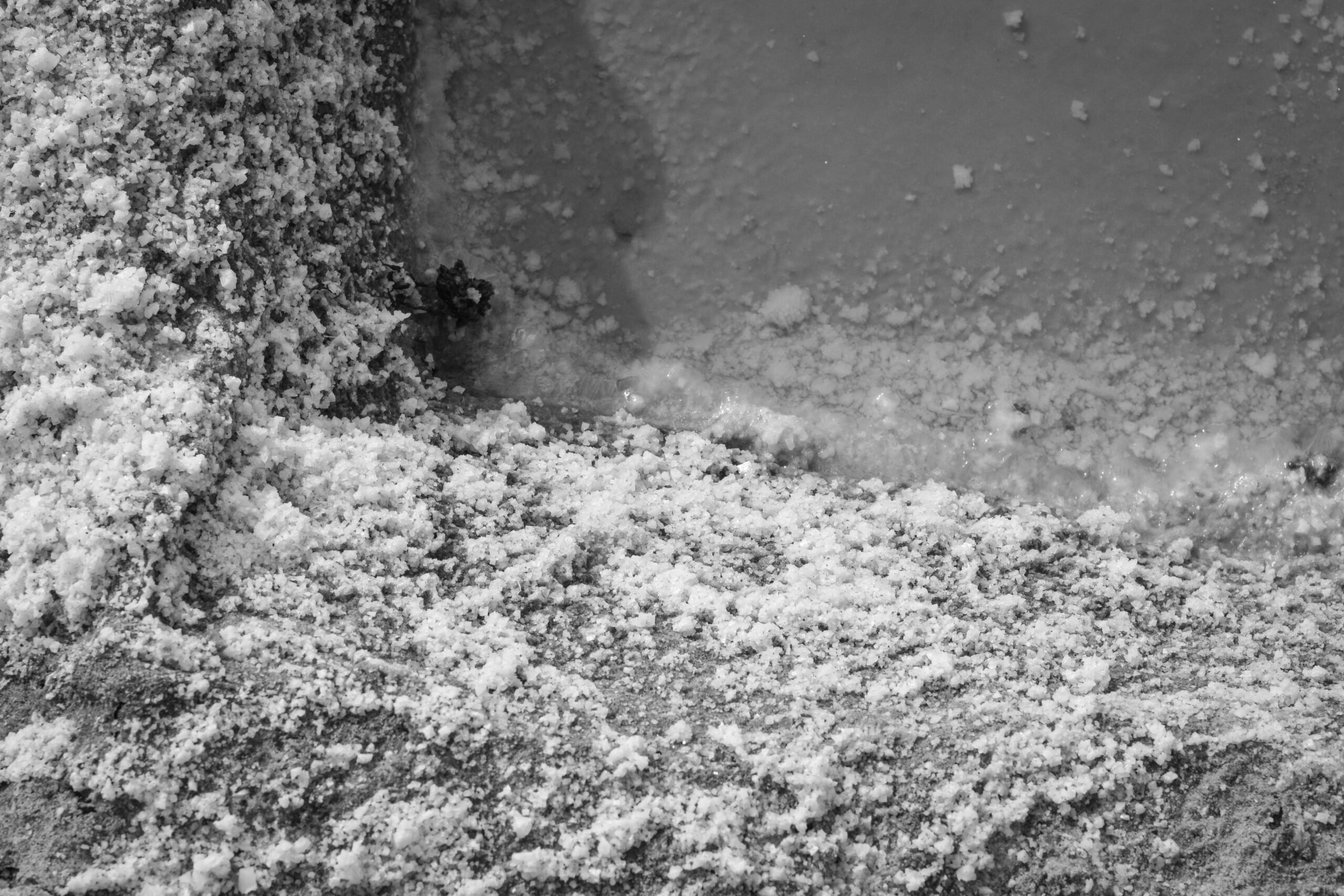
Every year, from the first harvest of the season, a small salt Ganesha is shaped by hand. He is then allowed to dissolve back into the salt pans. While it was the wrong time of year to witness this, my visit to Marakkanam did end with a quick stop at the 1000 year old Bhoomeeshwarar temple, dating to the Chola dynasty. I had been told that the temple’s inscriptions had mention of the salt trade in this area even a millennium ago. The priest said he didn’t think there was anything of that kind there, but sometimes we don’t know what’s right under our noses. Like salt, I suppose – that ubiquitous condiment we often only think about if it’s missing.
I’m not sure if salt was mentioned on them, but what struck me about the inscriptions all over the temple’s inner compound was this: how much the wear and tear of centuries on stone had made it look as though salt was on them. In between the chiselled spaces. In the air… and everywhere.
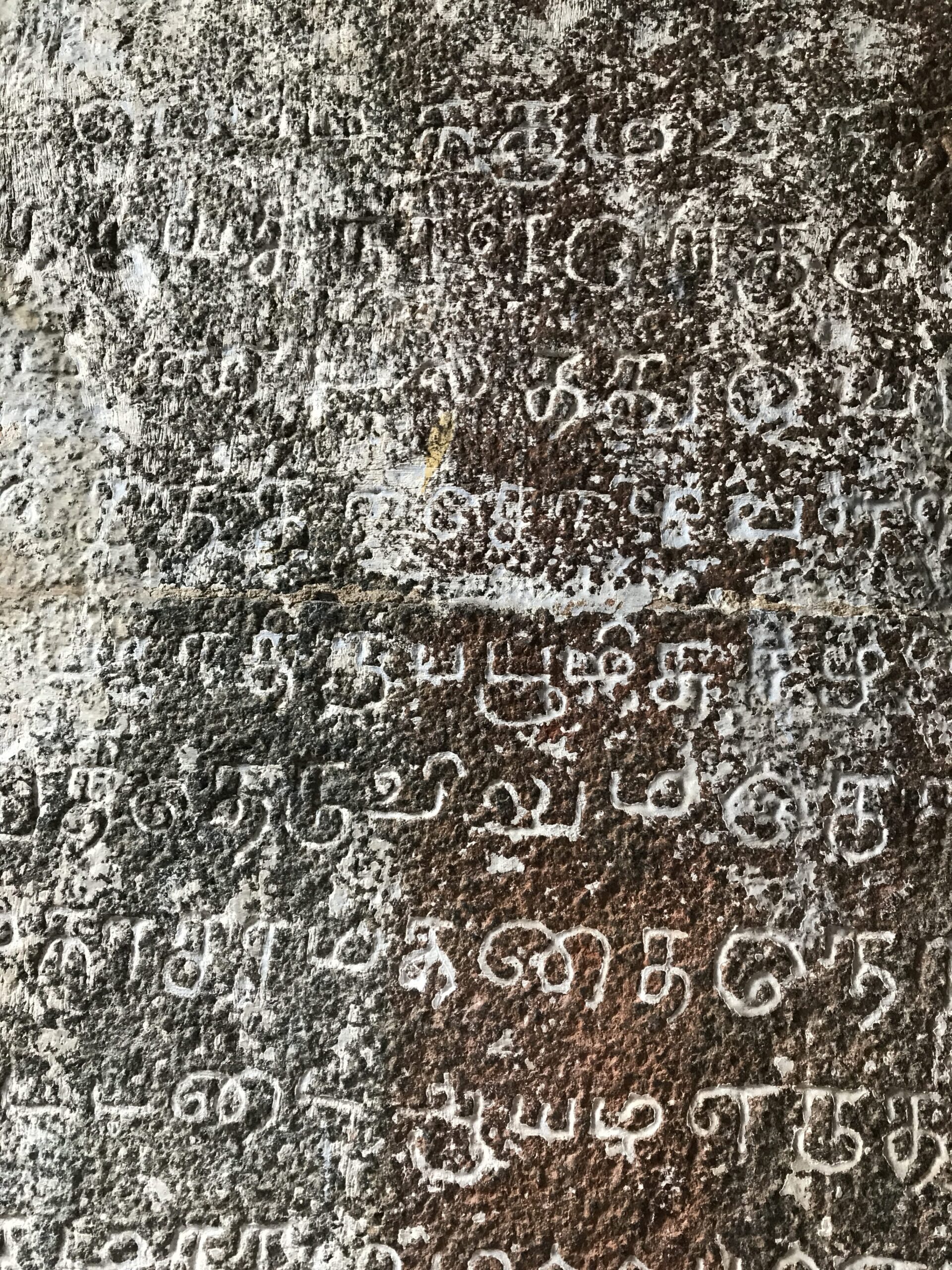
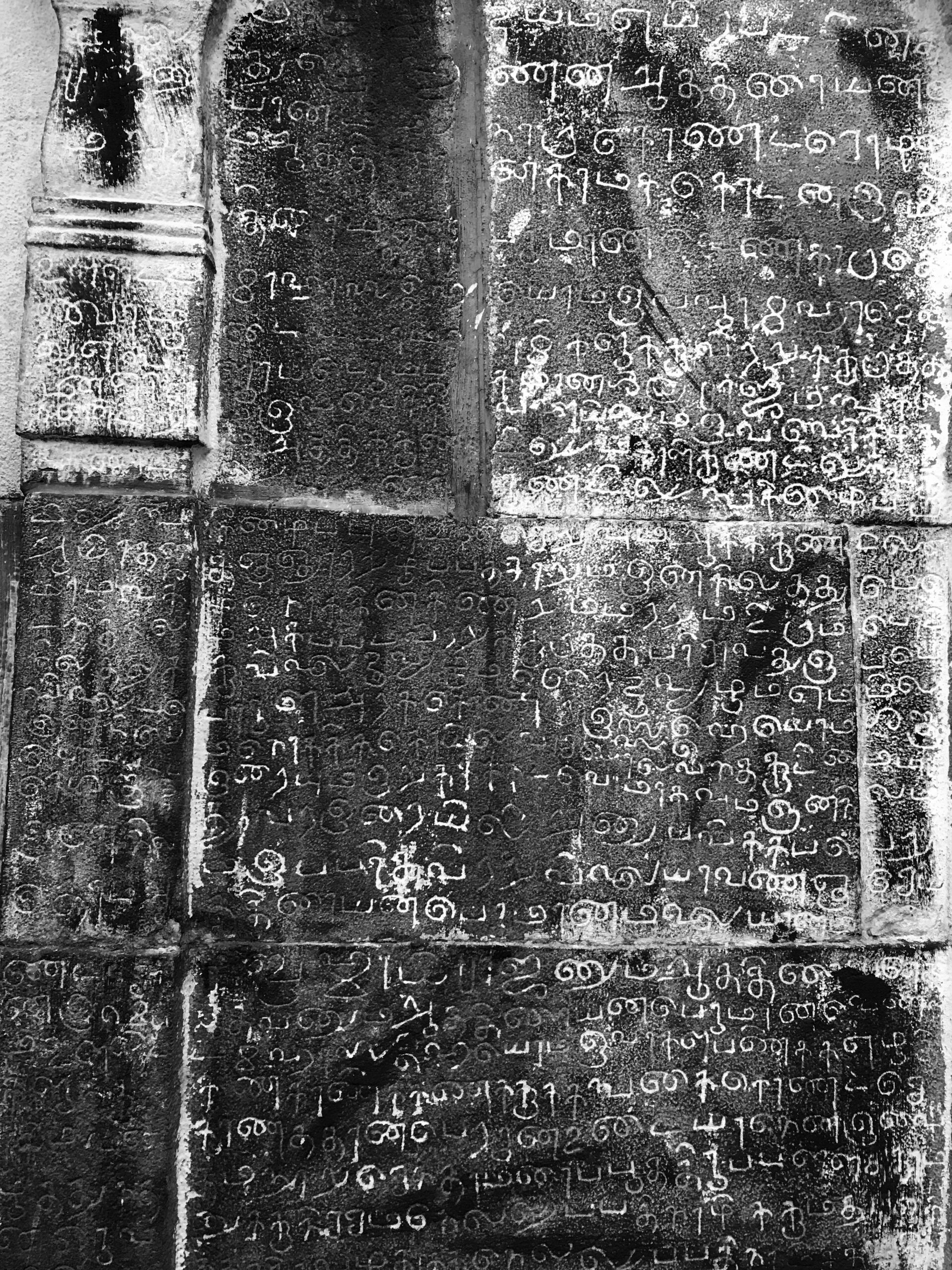
I had wondered about salt since childhood, that staple of every meal. My mother had taught me that in the precise quantity, it cooks vegetables faster. For years, on every long weekend drive to Pondicherry, I had watched the white salt mounds pass by and wondered about them too. Now, armed with my camera and my curiousity, I had discovered more. That indispensible ingredient comes from somewhere: the labour of people like Mr. Nallathamby and his staff. From those huge mounds that can be seen on the highway to the small pinch that is baked into our daily bread, how much we take for granted.
What does summer look and feel like in your city? Here in Chennai, temperatures have been crossing 40 °C (104 °F) – and we’re bracing for May, usually the hottest month of the year! The streets are at their sunniest and most scorching, but pleasantly lined by flowering trees and stalls selling fruit. A few weeks ago, on a short road trip, water mirages accompanied me all along the highway. As for what the season feels like: sweat, thirst and the longing for a cool breeze and a chilled beverage are our primary sensations at present. Come visit, I say – just not today!
Fortunately, there’s a method to the madness of every season. Traditional wisdom and the science of macrobiotics make the best culinary use of fruits, vegetables and grains that thrive at different times of the year. Here in the subcontinent, if there is one kind of produce that is ubiquitous with the sweltering, sultry days of summer, it’s the mango.
The dessert du jour is the chia seed pudding – fuss-free, and usually requiring very few ingredients. If you’re like me, you’d have gotten introduced to chia seeds because of your curiosity over the current craze of having them in puddings. The first time I tasted them, they took me back to childhood visits to Bombay and the city’s famous bright-coloured, super-sweet dessert drink known as falooda. They tasted just like the takhmaria (sweet basil) seeds I loved catching between my teeth as I slurped it down… And that’s when I had an inspiration about a very Indian twist on the done-to-death chia seed pudding.
Call it a tale of two cities, or a tale of two cups! Like many who love travelling, I form bonds with now-familiar niches all over the world. And between two such niches, I found a particular connection. A connection that smells like heaven and tastes like perfection… Coffee.


